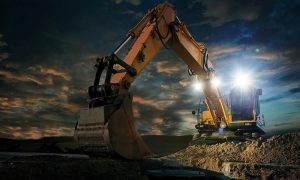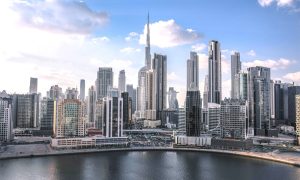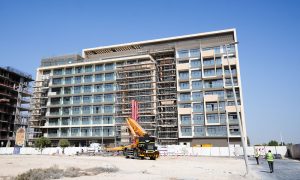Height of safety: working on elevated platforms
The International Powered Access Federation’s first Middle East event looked at how to ensure safety while working with powered access platforms

Safety at height came under the scanner at the International Powered Access Federation’s (IPAF) first Middle East event, held last month at the Address Hotel, Dubai Marina. The event was attended by manufacturers, rental companies, safety professionals and government representatives, who gathered to discuss best practices to ensure safety of workers operating at heights, focusing on mobile elevated work platforms (MEWPs).
“We’ll work with anyone, anywhere in the world, to keep MEWPs safe,” says Tim Whiteman, managing director and CEO, IPAF.
“Things can go wrong with MEWPs, but they are a very safe way of doing temporary work on height. Falls from height are the biggest cause of fatal accidents in Europe, in North America, in China. And MEWPs are an important part of the solution.”
Workplace safety is a pressing issue in the Gulf. In 2011, 71 occupational fatalities were recorded in the emirate of Abu Dhabi, says Matt Cox, chairman, IIRSM (International Institute of Risk & Safety Management) Middle East and corporate HSE manager at Ed Zublin. Of the 71 deaths, 26 were caused by a fall from height, while another 26 were the result of falling objects, meaning 73% of the deaths were height-related. “I’m pleased to report that the trend is improving, but the percentage remains constant at about 75%.”
With this in mind, how can employers ensure that workers stay safe when working at height?
Rob Cavaleri, regional operations and technical manager at Manlift Middle East and chairman of IPAF UAE, emphasises the importance of assessing ground conditions before setting up a MEWP. “Unsuitable ground conditions present a real hazard. Understanding the ground surface type, and what may be under the ground, below the area of intended operation of a MEWP, is critical,” Cavaleri explained to the audience, reminding them to beware of “poor ground assessment, poor spreader plate selection and incorrect positioning of outriggers”.
“Unstable ground conditions are everywhere. No matter if we’re thinking about a construction site application or a city centre or factory floor environment, we must always do risk assessment and make sure that the ground is okay, that the machine can travel to the work area, and when it gets to the work area it’s safe to elevate.
“To provide stability, MEWPs use a combination of chassis plate and surface area provided by the unit’s base dimensions, including wheel-mounted MEWPs, outrigger-mounted MEWPs or models that use both. Ground conditions will adversely affect stability if they fall outside the design and intended use criteria,” cautions Cavaleri, whose firm lets and sells powered access equipment and generators.
Several dangerous practices abound in the industry, he explains, such as mounting a MEWP on a truck body where a chassis can move, which can potentially result in a tip-over. Weather conditions are also important.
So whose responsibility is it to ensure that ground conditions are suitable and MEWPs are used properly on-site? Although there’s a clear hierarchy on large worksites, Cavaleri says this is not always the case when smaller companies are involved.
“It’s the principal contractor’s responsibility to ensure that ground conditions, including supporting structures and traffic, are suitable for the loads being imposed on the mobile elevating work platform.”
Prior to work commencing on the site, the principal contractor should ensure that the contractor selecting the mobile elevated work platform is provided with relevant details on ground bearing capacity and load bearing capability of supporting structures, including the location of underground services, ducts [and so on]. The contractor should provide details of intended imposed loads.”
Additionally, contractors should ensure that the MEWP isn’t loaded beyond its capacity, he urges.
Operator training is also a critical part of the equation. “Operators are not geotechnical engineers. Good training and experience is essential to confidence of operators… [their] experience and expertise will usually determine safe setup. If doubt exists, there is a need for further expert advice and assessment.”
Moreover, if uncertainty exists over whether the MEWP will remain stable, it is better to tread on the side of caution and use a spreader plate.
“It is strongly recommended that suitable spreader plates should always be used under the outrigger, irrespective of the apparent ground conditions.”
For wheel-mounted platforms, paying attention to tyres is important, Cavaleri adds. “When mobile elevated work platforms are supported on wheels and tyres, the vast majority will be foam-filled or solid tyres. However, stability can be compromised on the use if the wrong compound is used to fill the tyres. A specific hardness of the material needs to be understood and used for both foam-filled tyres and solid tyres. If the material that’s used to fill the tyres is too soft, a stability hazard will arise.”
Cavaleri also highlights the need for carrying out a risk assessment beforehand. “We need to risk-assess the work area. When we’re setting up a mobile elevated work platform, we need to examine the site plan. We need to walk the route, we need to look for drains, manhole covers, underground services. All pose potential risk to your work platform.”
Despite the safety information being available to anyone who’s interested, why are workplace injuries and fatalities still common in the country?
“Many companies here in the UAE don’t bother themselves when it comes to safe practices at worksites. Some of them, they think that it’s a burden, it’s an extra expense. Unfortunately, some of them have the mentality that workers are replaceable,” says Dr Ali Salem, Director of the Ministry of Labour.
“We consider it as a simple human right to protect workers wherever they are. If you protect your workers, then basically you are protecting your own investment. It is not a waste of money to pay someone to try to at least do some risk management, to try to do some safety planning for your company.”

















